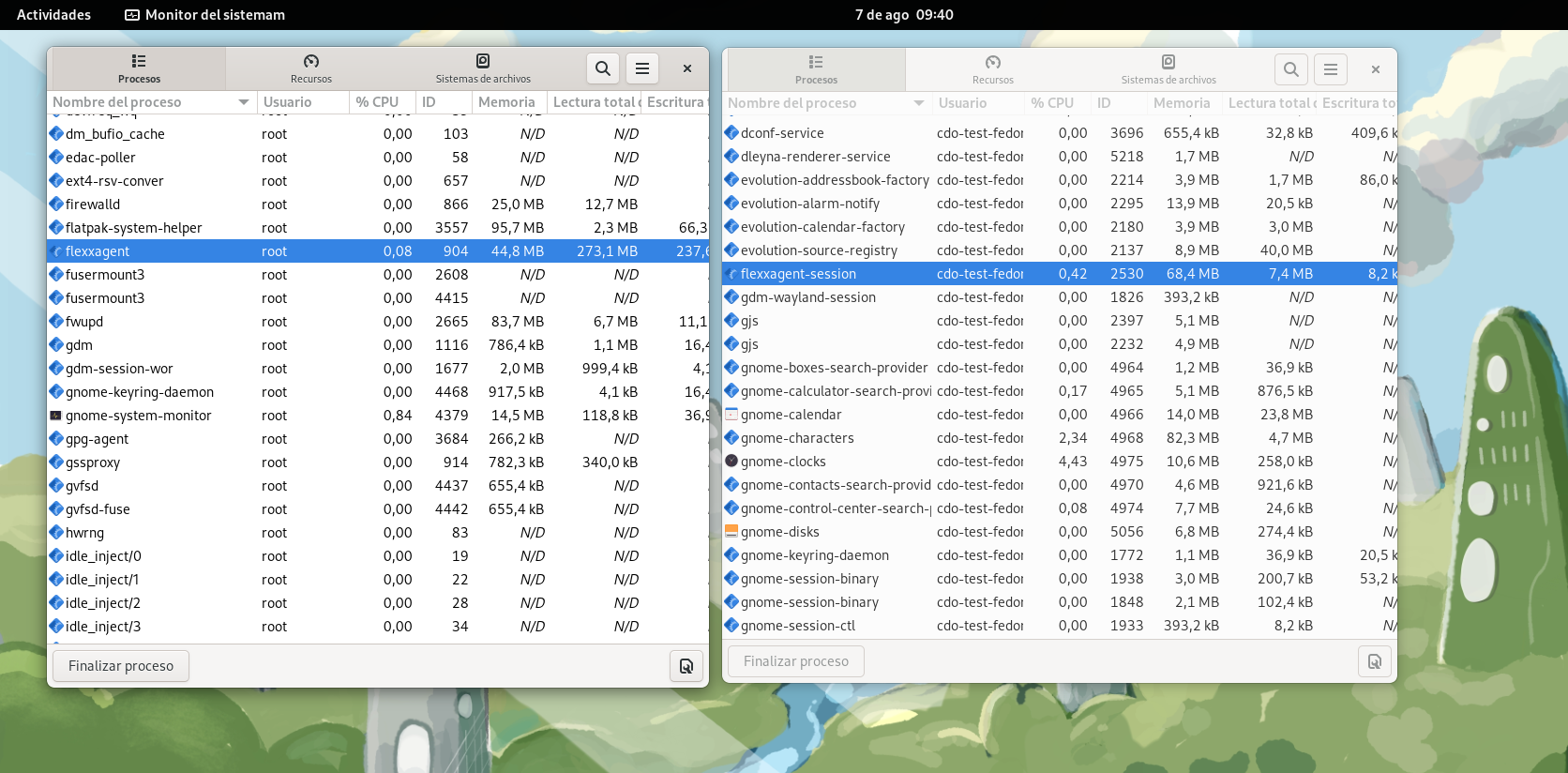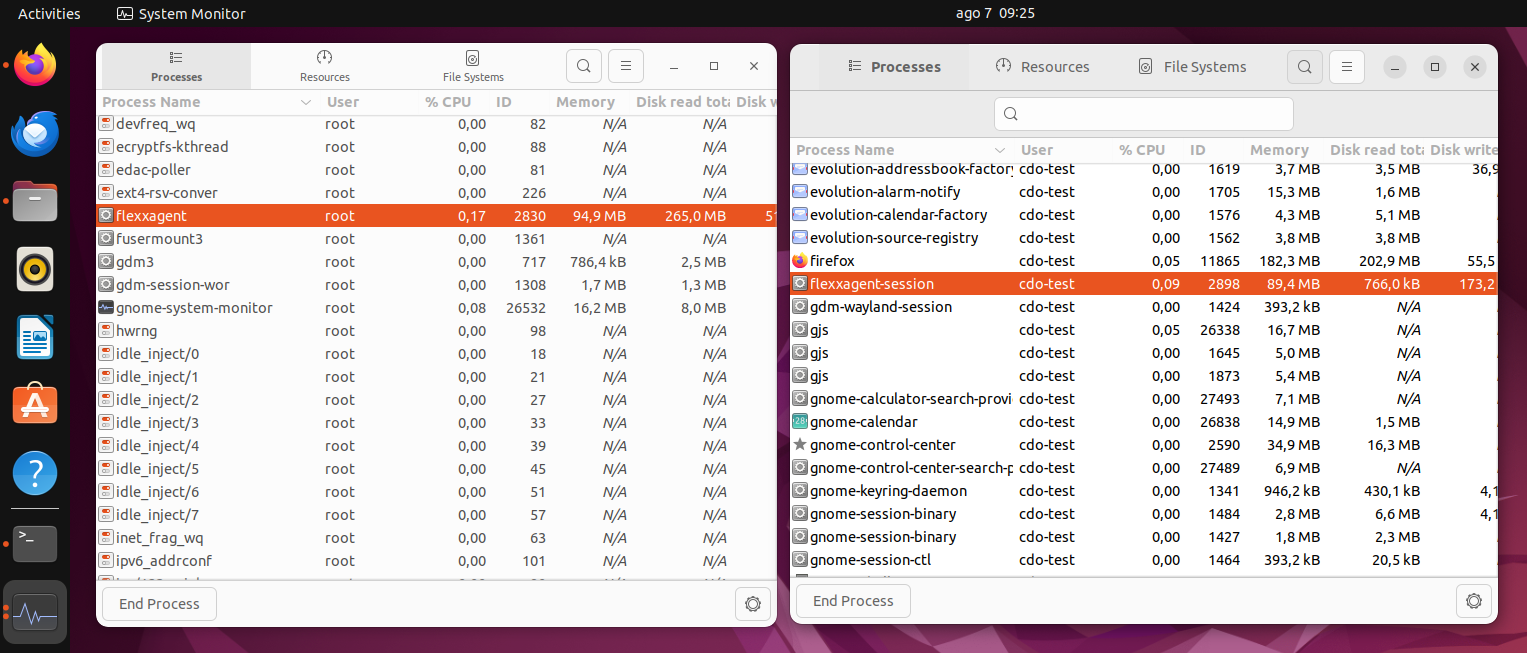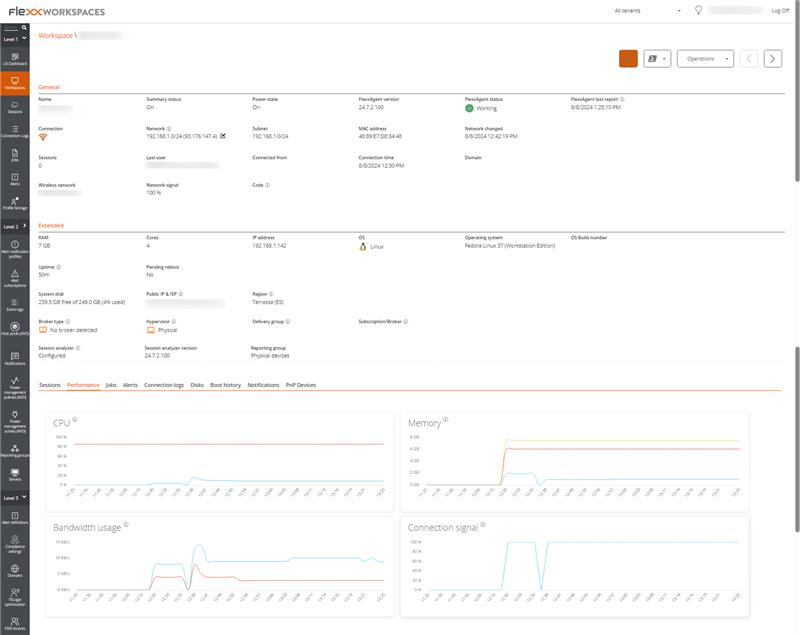Linux
The Linux agent allows the inclusion of devices with this operating system in the service consoles, enabling support teams to have complete visibility of all devices in use within the organization.
Linux support includes distributions like Fedora, Debian, and its derivative, Ubuntu. Both physical and virtual devices on VMware as a hypervisor and VDIs published with Citrix as a broker are supported.

FlexxAgent is composed of a process of the same name, which runs at the system level and obtains all device information: its consumption metrics, performance, and all information visible in the consoles related to the device.
FlexxAgent-Session initiates an instance for each user session on the device. It gathers information about the session, such as the applications in use and their consumption, system resource usage by the session, and session delivery times.

Supported versions
FlexxAgent supports the following distributions and versions:
- Fedora 37 or later
- Debian/GNU Linux 11 (bullseye) or later
- Ubuntu 22.04, 24.04
More distributions are regularly validated.
To include a distribution in the list of supported distributions, please contact Flexxible.
Requirements
Before installing, updating all system packages is recommended. The necessary components will be installed, depending on the distribution.
Package dependencies for Fedora and Debian:
- dmidecode
- imvirt
- systemd
Limitations
Certain features are not available for Linux, such as Flexxible Remote Assistance, user microservices, or the execution of flows, as well as the collection of plug and play peripheral data.
The on-demand execution of microservices from Workspaces supports Bash as a scripting language.
Proxy Configuration
FlexxAgent for Linux supports communication through authenticated and unauthenticated proxies. The proxy information must be provided to Flexxible to include it in the configuration file mentioned in the next point.
Required data:
- For unauthenticated proxy, it will be necessary to provide
URLandPort. - For authenticated proxies,
UserandPasswordmust be added to the above.
Download and installation
To install FlexxAgent, you must run the installation script using a preset configuration file.
Installation Scripts
Path to download the installation script on Ubuntu/Debian:
https://update.workspaces.flexxible.com/agents/FlexxAgent/latest/debian/x64/flexxagent-install.sh
Path to download the installation script on Fedora:
https://update.workspaces.flexxible.com/agents/FlexxAgent/latest/fedora/x64/flexxagent-install.sh
FlexxAgent downloads its latest version when the script is executed before installation.
The configuration file should be downloaded from the Reporting Groups section in the Workspaces module.
Installation steps
- Download the installer from the URL.
- Grant permissions to the script.
sudo chmod +x ./flexxagent-install.sh - Run the script.
sudo ./flexxagent-install.sh -c [configuration file] - Clean the files used.
Installation script parameters
| Parameter | Caption |
|---|---|
-v,--version <VERSION> | Use a specific version, by default latest. |
-d,--distro <DISTRO> | The script automatically detects the DISTRO in use on the system it is running on. This parameter helps force the FlexxAgent version installation for a specific DISTRO when working with derived or similar distros. |
--verbose,-Verbose | Displays diagnostic information. |
-c,--config <CONFFILE> | Applies the configuration from a configuration file by default, settings.conf. |
-o, --offline | Installs FlexxAgent from a given package file, instead of downloading it. Please check the Offline installation section for more details. |
-?,--?,-h,--help,-Help | Shows help. |
Examples
Install FlexxAgent with the configuration file:
flexxagent-install.sh [-c|--config <path/file.conf>]
Install a specific version of FlexxAgent:
flexxagent-install.sh [-v|--version <VERSION>]
Force the FlexxAgent installation for a specific distribution:
flexxagent-install.sh [-d|--distro <DISTRO>]
Access the help:
flexxagent-install.sh -h|-?|--help
Offline installation
Offline installation is available if there is some networking restriction in your environment. To perform an offline installation, please ask your contact at Flexxible how to obtain the package and installer for your distribution.
Installation packages provided according to the distribution
Debian:
flexxagent.deb
Fedora:
flexxagent.rpm
Offline installation steps
-
Place the FlexxAgent package file, the configuration file, and the installation script in the same folder.
-
Grant permissions to the script:
sudo chmod +x ./flexxagent-install.sh
- Run the script with the
-oor--offlineparameter and indicating the name of the package file to install:
sudo ./flexxagent-install.sh -c [archivo de configuración] -o [paquete de Flexxagent]
- Clean the files used.
Uninstall
The uninstallation script can be downloaded from
https://update.workspaces.flexxible.com/agents/Linux/FlexxAgent/latest/flexxagent-uninstall.sh
Steps for uninstallation:
-
Download the uninstaller from the URL.
-
Grant permissions to the script.
sudo chmod +x ./flexxagent-uninstall.sh -
Run the script.
sudo ./flexxagent-uninstall.sh -
Clean the files used.
Uninstallation script parameters
| Parameter | Caption |
|---|---|
-d,--distro <DISTRO> | The script automatically detects the DISTRO in use on the system it is running on. This parameter helps force the FlexxAgent version uninstallation for a specific DISTRO when working with derived or similar distros. |
-c,--cleanup <VERSION> | Cleans configurations and logs; default is false. |
-?,--?,-h,--help,-Help | Shows help. |
Examples
Uninstall and clean up configurations and logs:
flexxagent-uninstall.sh [-c|--cleanup]
Force the uninstallation for a DISTRO:
flexxagent-uninstall.sh [-d|--distro <DISTRO>]
Access the help:
sudo ./flexxagent-uninstall.sh --help
Update
There are two ways to update FlexxAgent to its latest version:
- From Workspaces, select the device and perform:
Operations -> FlexxAgent -> Update to the latest version. - Re-running the installation script to download and install the latest version.
Logs
FlexxAgent can generate two types of logs:
- FlexxAgent log (system): located in the
/var/log/flexx/folder - FlexxAgent Session log (user session): located in the
/home/[user]/.config/flexx/logs/folder
Information obtained from the device
FlexxAgent collects data locally from the device and sends it to the service consoles.

General information
- Name. Device Name.
- Device Status. Power status of the device, can be On, Off, or Not reporting.
- FlexxAgent Version. Version number of FlexxAgent installed on the device.
- FlexxAgent Status. Running or Stopped.
- Last FlexxAgent report. Date and time of the last FlexxAgent report on the device. This date might not be recent if the FlexxAgent service is stopped or the device is off.
- Connection Type. Indicates if the device is connected via Wireless LAN, Mobile Network, Ethernet, or Unknown.
- Network. Network addressing of the device and public IP for internet access. These networks are created automatically when more than four devices are connected to the same network.
- Network Signal. Network reception percentage.
- Subnet. Device's network addressing.
- MAC Address. Unique identifier of the device's network card.
- Wireless Network. Name of the network.
- Connection signal. Percentage of signal reception when the device connects using a wireless method.
- Network Changed. Date and time of the last network change.
- Sessions. Number of user sessions on the device.
- Last User. Last user logged into the device in domain\account format.
- Connected From. When the selected device is a VDI or similar, shows the device name from which the virtual device is accessed.
- Connection Time. Date and time when the session started.
- Code. Lets identify the device with a personal code. This code must be manually filled in individually using the Edit option in the Operations menu of the workspace details.
- Description. Allows the user to identify the device with a personal description. This field must be assigned manually and individually using the Edit option in the Operations menu of the device details.
Extended Info
- RAM. Total capacity of available RAM.
- Cores. Number of processor cores.
- IP Address. Device's IP address on the local network.
- OS. Type of operating system.
- Operating System. OS version.
- Region. Obtained using the public IP. It might not be accurate if connected to a corporate network or using a VPN.
- Broker type. If detected, shows the session broker used.
- Delivery group. For VDIs, shows the delivery group to which the device belongs.
- Subscription. If detected, subscription in use for Citrix Cloud, Azure services, etc.
- Hypervisor. If virtualization is detected, shows the hypervisor used.
- Session Analyzer. Indicates whether or not it's configured to launch session Analyzer in all user sessions.
- Session Analyzer Version. Version number of Session Analyzer.
- Report Group. Reporting group to which the device belongs.
Information in tabs
FlexxAgent groups information about the following aspects of the device:
Sessions
Displays a table with the log of user sessions established on the device and timely information about the session type, connection status, or start date.
Performance
Displays graphs of the device's main performance counters, based on data collected over the last two hours. The following are included:
- CPU. Processor usage percentage.
- Memory. Amount of memory used and available.
- Bandwidth Usage. Amount of incoming and outgoing traffic.
At the top, a link grants access to the Analyzer module.
Job
All actions performed from the Workspaces module on one or more devices are audited in the Jobs queue. This tab allows you to check the work done for the active device.
Alert
Presents a table with the list of all active alerts on the device. When an alert is logged, a notice is displayed at the top of the page.

Connection Log
Presents a list of the connections established with the device, including each instance where a user logs in or reconnects a previously disconnected session.
The session end date is recorded only for sessions that have been disconnected or closed. While the session remains active, this field will remain empty.
Disks
Displays a list of all partitions present on the disks identified in the system, as well as statistics of their capacity and occupancy levels.
Notifications
Allows you to see if the device has any active notification. When there is one, a message is displayed at the top of the page.
Reporting groups history
Allows you to see which reporting groups the device belongs to, the date of incorporation, and if it has been assigned to the group manually or automatically.